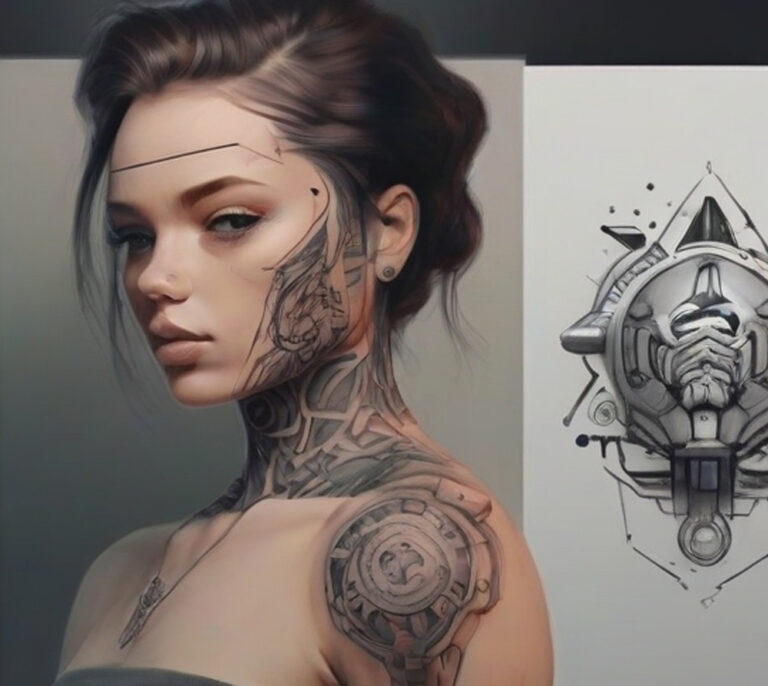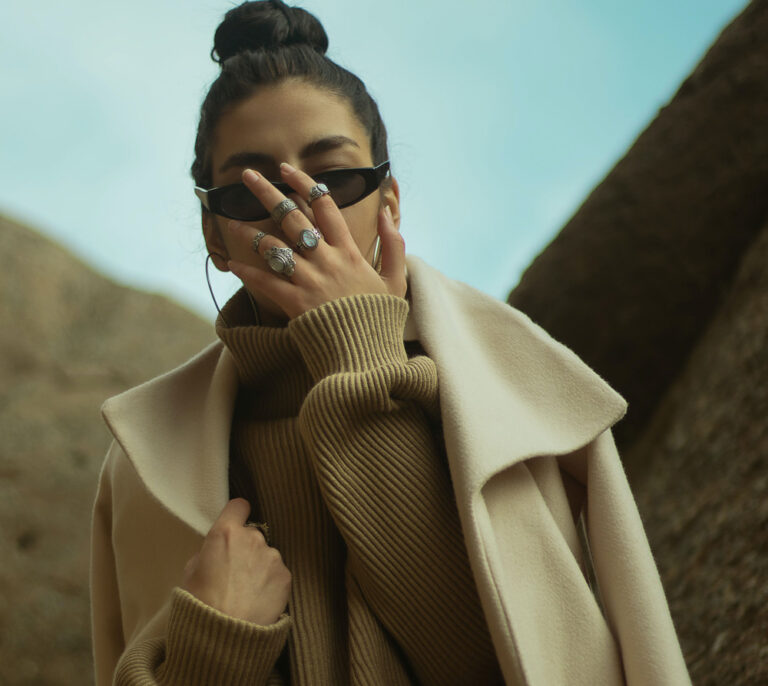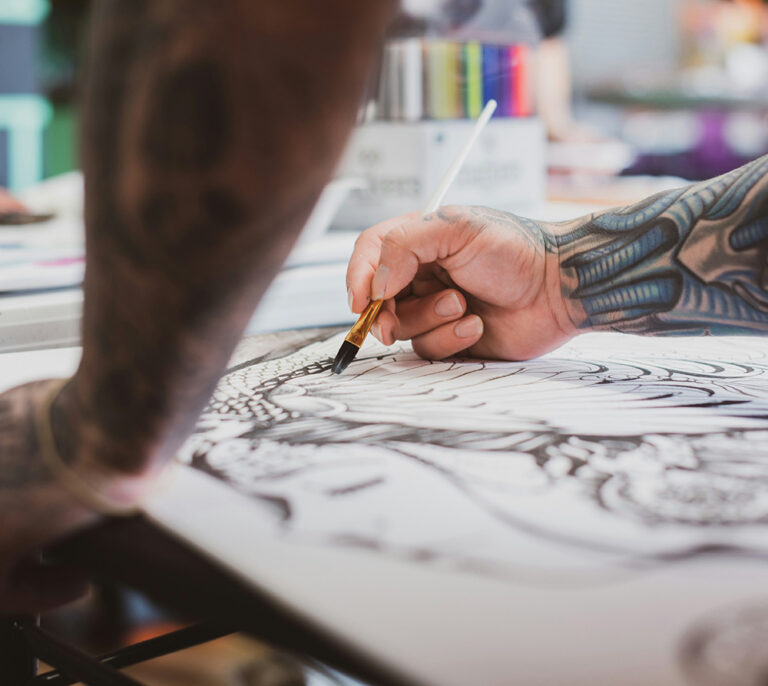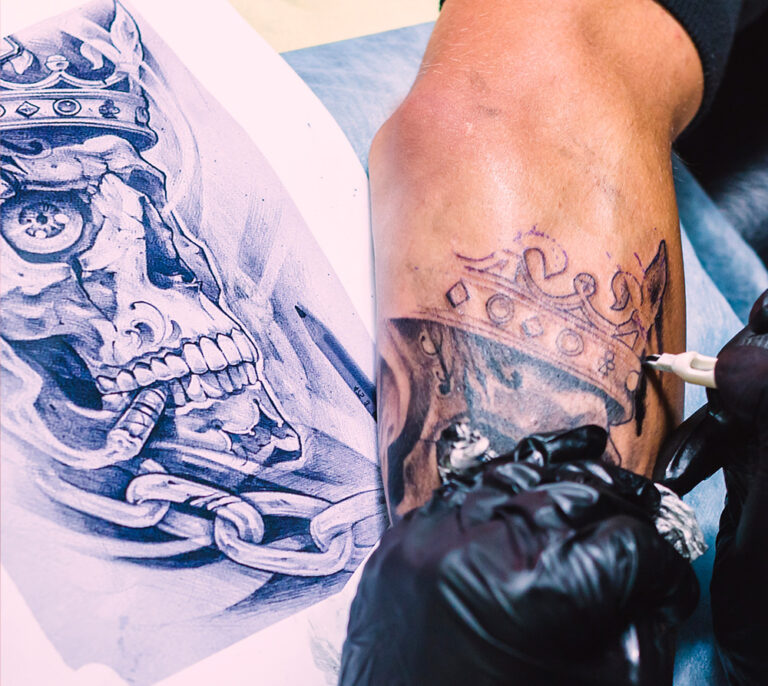Tattoo Cover Up
Covering up tattoos can present a unique set of challenges for tattoo artists. The difficulty level of a cover-up largely depends on several factors, including the size, color, and style of the existing tattoo, as well as the chosen design for the cover-up. Here are some factors that contribute to the complexity of cover-up tattoos:
Existing Tattoo Characteristics
- Dark and Bold Tattoos: Home provides a comfortable and familiar setting, reducing anxiety often associated with formal tattoo studios. Learn more detail
- Fine Line or Faded Tattoos: While fine line tattoos or those that have faded over time might be easier to cover, the artist still needs to ensure that the new design effectively conceals the old one. Learn more detail
Color Considerations
- Color Matching: Matching the colors of the cover-up design with the existing tattoo is crucial. If the new design incorporates colors that clash with the old tattoo, achieving a seamless cover-up becomes more difficult.
.
- Black and Grey Options: Many cover-ups utilize black and grey designs to neutralize the colors of the original tattoo, providing a more effective cover.
Design Selection
- Strategic Planning: Choosing a cover-up design that strategically incorporates and conceals the existing tattoo requires careful planning. The artist needs to consider the size, style, and placement to achieve optimal results.
.
- Creativity: Transforming an existing tattoo into a new, aesthetically pleasing design often requires creative problem-solving skills.
Technique and Skill
- Blending Techniques: Skilled tattoo artists employ various blending techniques to seamlessly integrate the new design with the old tattoo. This includes using shading, negative space, and other artistic techniques.
.
- Experience Matters: Experienced tattoo artists who specialize in cover-ups often have a better understanding of how different inks and techniques interact, enhancing their ability to create successful cover-ups.
Client Expectations
Managing Expectations: Effective communication between the tattoo artist and the client is crucial. Managing client expectations regarding the outcome and potential limitations of a cover-up is an essential part of the process.
Aftercare and Healing
Ensuring Proper Healing: Aftercare is vital for any tattoo, but it becomes even more critical for cover-ups. Proper healing ensures that the new design settles well into the skin and retains its clarity.
While cover-ups can pose challenges, skilled tattoo artists with experience in this niche often relish the opportunity to turn a previous tattoo into a work of art that both the artist and the client can be proud of. It's a collaborative process that requires expertise, creativity, and a thorough understanding of tattooing techniques.
What Tattoos Are Hardest to Cover?
Tattoos, once etched into the canvas of the skin, become lasting expressions of personal art and identity. Yet, the desire for change or a new chapter often prompts individuals to seek cover-up options. In this article, we'll embark on a journey into the realm of tattoos, exploring the intricate ink challenges that make certain designs the toughest to conceal.
1. Dark and Bold Designs
The Challenge: Dark and bold tattoos, rich in ink saturation, present a significant challenge for cover-ups. The intensity of the colors and the density of the design make it difficult to find a new pattern that effectively conceals the original artwork.
Optimal Approach: Covering up dark tattoos may involve opting for an equally bold design or incorporating strategic elements like geometric patterns or abstract shapes to divert attention.
2. Intricate Fine Line Tattoos
The Challenge: Fine line tattoos, while delicate and detailed, pose a challenge due to their intricacy. The fine lines can be tough to cover without compromising the clarity and precision of the new design.
Optimal Approach: Artists may need to use techniques like negative space, clever shading, or incorporating the existing lines into a new pattern to effectively conceal fine line tattoos.
3. Bright and Vibrant Colors
The Challenge: Tattoos with vibrant and bright colors, especially neons and fluorescents, can be challenging to cover. Achieving a color match that seamlessly blends with the original hues is often tricky.
Optimal Approach: Covering up bright colors may involve neutralizing them with darker tones or opting for a design that strategically integrates the existing colors into a cohesive new pattern.
4. Text and Script Tattoos
The Challenge: Text and script tattoos, particularly those with intricate fonts, pose difficulties in covering due to the need for precise lettering and spacing.
Optimal Approach: Covering up text tattoos may require creative design solutions, such as transforming the letters into abstract shapes, incorporating them into a larger image, or using negative space strategically.
5. Watercolor Tattoos
The Challenge: Watercolor tattoos, known for their fluid and abstract designs, can be challenging to cover due to the lack of defined outlines and the blending of colors.
Optimal Approach: Covering watercolor tattoos often involves incorporating the existing hues into a new design or using darker shades to create a more structured pattern.
6. Tattoos on Sensitive Areas
The Challenge: Tattoos on sensitive areas like the hands, fingers, or face can be challenging to cover due to the constant movement and exposure of these areas.
Optimal Approach: Artists may need to choose designs that complement the natural contours of the body or consider partial cover-ups that blend seamlessly with the surrounding skin.
Conclusion: Navigating the Tapestry of Cover-Ups
While covering tattoos poses its challenges, skilled tattoo artists navigate the intricacies of each design to create transformative cover-ups. The optimal approach often involves a blend of artistic creativity, strategic planning, and an understanding of various tattooing techniques. As individuals seek new beginnings through cover-up tattoos, artists embark on a journey of innovation, turning ink challenges into masterpieces.
Ready to Transform Your Tattoo Story?
Whether it's a dark and bold design, intricate fine lines, or vibrant hues, skilled tattoo artists possess the expertise to turn tattoo challenges into opportunities for artistic renewal. Consult with a professional artist to explore the possibilities of transforming your existing ink into a fresh and personalized masterpiece.
What Tattoos Are Easiest to Cover?
In the ever-evolving world of tattoos, the desire for change or a fresh expression often leads individuals to explore the art of cover-ups. Not all tattoos present the same challenge, and some designs are more amenable to transformation than others. In this article, we'll unravel the art of concealment, focusing on tattoos that are easiest to cover and offering a blank canvas for new beginnings.
1. Faded Tattoos
The Advantage: Faded tattoos, whether due to age, sun exposure, or natural wear, are often the easiest to cover. The softened lines and diminished colors provide a more forgiving backdrop for a new design.
Optimal Approach: Artists can leverage the faded nature of the tattoo to create a fresh design, incorporating new elements or choosing lighter colors to seamlessly blend with the existing ink.
2. Simple and Small Designs
The Advantage: Small and simple tattoos, particularly those with minimal details, are generally easier to cover. Their uncomplicated nature allows for more flexibility in choosing a new design.
Optimal Approach: Covering small tattoos may involve selecting a larger design that envelops the existing ink or opting for a new, more intricate pattern that complements the simplicity of the original tattoo.
3. Black and Grey Tattoos
The Advantage: Black and grey tattoos, characterized by a monochromatic palette, offer an advantage in cover-ups. The absence of vibrant colors simplifies the process of creating a cohesive new design.
Optimal Approach: Artists can choose a black and grey design that strategically incorporates the existing tattoo or use shading techniques to seamlessly blend the old with the new.
4. Old School Traditional Tattoos
The Advantage: Old school traditional tattoos, featuring bold lines and classic motifs, are often easier to cover. The well-defined shapes lend themselves to creative cover-up solutions.
Optimal Approach: Covering traditional tattoos may involve choosing a design that respects the classic aesthetic while introducing modern elements or incorporating the existing lines into a new pattern.
5. Neutral Colors and Earth Tones
The Advantage: Tattoos with neutral colors or earth tones, such as browns and greens, are easier to cover. These colors allow for more flexibility in selecting a new design without the need for extensive color matching.
Optimal Approach: Artists can choose cover-up designs that complement or incorporate the neutral colors, creating a harmonious transition from the old to the new.
6. Tattoos in Less Exposed Areas
The Advantage: Tattoos in areas less exposed to sunlight and constant movement, such as the upper back or torso, are generally easier to cover. These areas provide a more stable canvas for the new design.
Optimal Approach: Artists may choose cover-up designs that complement the natural contours of the body or opt for partial cover-ups that seamlessly integrate with the surrounding skin.
Conclusion: A Fresh Start on the Canvas of Change
As individuals seek a fresh start through cover-up tattoos, the ease of transformation often depends on the nature of the existing ink. Faded tattoos, simple designs, black and grey palettes, traditional motifs, neutral colors, and strategic placements provide a favorable canvas for artistic renewal.
Ready for Your Tattoo Transformation?
If you're contemplating a tattoo cover-up, explore the possibilities with a skilled tattoo artist. From faded memories to simple designs, the ease of covering certain tattoos opens doors to a world of artistic reinvention. Consult with a professional to turn your existing ink into a blank canvas for a new chapter of self-expression.







